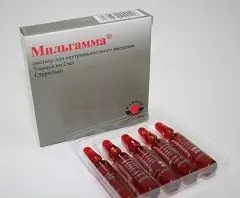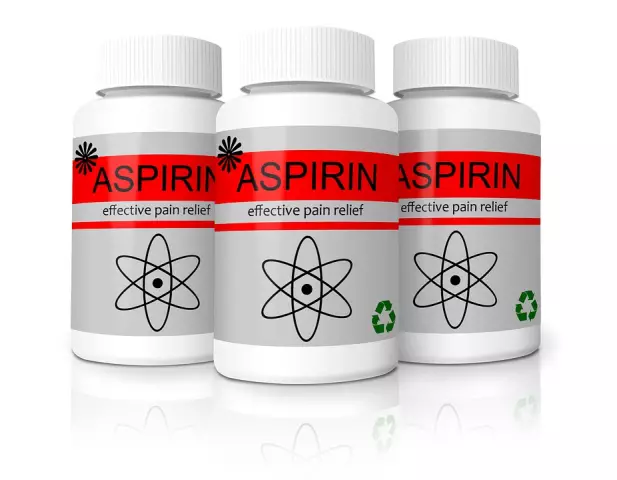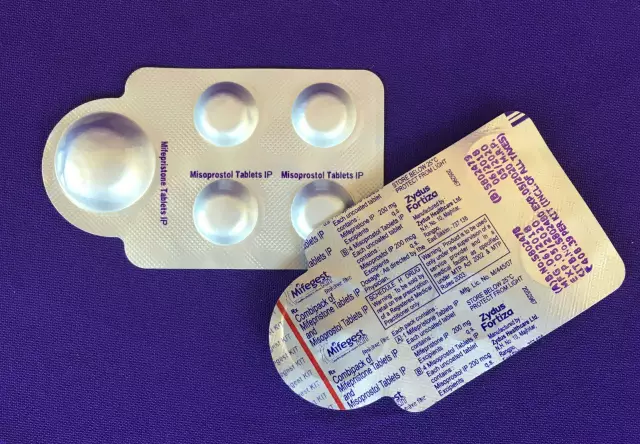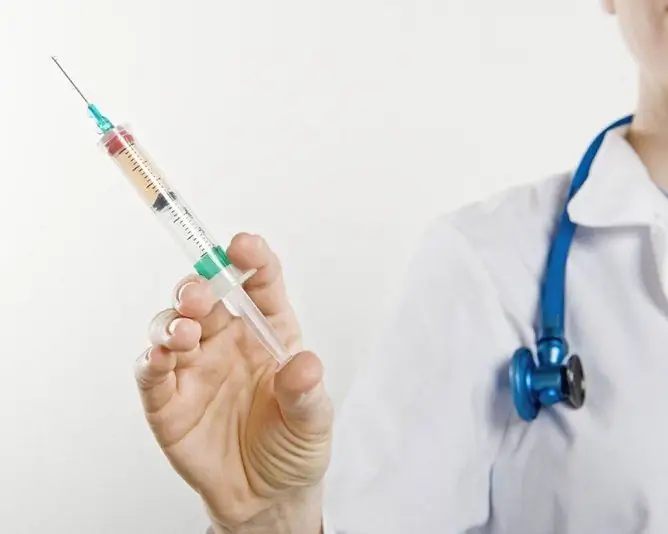- Author Rachel Wainwright [email protected].
- Public 2023-12-15 07:39.
- Last modified 2025-11-02 20:14.
Milgamma
Milgamma: instructions for use and reviews
- 1. Release form and composition
- 2. Pharmacological properties
- 3. Indications for use
- 4. Contraindications
- 5. Method of application and dosage
- 6. Side effects
- 7. Overdose
- 8. Special instructions
- 9. Use in childhood
- 10. Drug interactions
- 11. Analogs
- 12. Terms and conditions of storage
- 13. Terms of dispensing from pharmacies
- 14. Reviews
- 15. Price in pharmacies
Latin name: Milgamma
ATX code: A11EX
Active ingredient: pyridoxine + cyanocobalamin + thiamine + lidocaine (pyridoxine + cyanocobalamin + thiamine + lidocaine)
Manufacturer: Worwag Pharma GmbH & Co. KG (Germany)
Description and photo update: 2019-16-08
Prices in pharmacies: from 281 rubles.
Buy

Milgamma is a neurotropic complex of B vitamins.
Release form and composition
Dosage forms of Milgamma:
- Solution for intramuscular (i / m) administration: transparent red liquid (2 ml in dark glass ampoules, 5 pcs in a blister, in a cardboard box 1, 2 or 5 packages; in cardboard pallets: 5 pcs.., in a cardboard box 1 or 5 pallets, or 10 pcs., in a cardboard box 1 pallet);
- Dragee (15 pcs. In a blister strip, in a cardboard box 2 or 4 packs).
Content of active ingredients:
- 1 ml of solution: thiamine hydrochloride (B1) - 50 mg, pyridoxine hydrochloride (B6) - 50 mg, cyanocobalamin (B12) - 0.5 mg, lidocaine hydrochloride - 10 mg;
- 1 tablet: benfotiamine - 100 mg, pyridoxine hydrochloride - 100 mg.
Auxiliary components:
- Solution: benzyl alcohol, sodium polyphosphate, potassium hexacyanoferrate, sodium hydroxide, water for injection;
- Dragee: aerosil, calcium carbonate, titanium dioxide, microcrystalline cellulose, sodium carboxymethyl cellulose, povidone, shellac, fatty acid glycerides, sucrose, acacia powder, polyethylene glycol-6000, corn starch, glycerol, glycol wax, tween-80, talc.
Pharmacological properties
Pharmacodynamics
Neurotropic B vitamins have a positive effect on degenerative and inflammatory diseases of the locomotor system and nerves, activating blood flow and improving the functioning of the nervous system.
Thiamine is one of the most important elements in the process of carbohydrate metabolism, as well as in the Krebs cycle with subsequent participation in the synthesis of adenosine triphosphate and thiamine pyrophosphate.
Pyridoxine is involved in protein metabolism and is partially involved in the metabolism of fats and carbohydrates. The physiological function of thiamine and pyridoxine is to enhance the action of each other, which is expressed in a beneficial effect on the cardiovascular, neuromuscular and nervous systems. Lack of vitamin B 6 leads to the development of widespread deficiency states, which are stopped as soon as possible after the administration of thiamine and pyridoxine.
Cyanocobalamin plays an important role in the synthesis of the myelin sheath, enhances nucleic acid metabolism by activating folic acid, reduces the severity of pain caused by damage to the peripheral nervous system, and is a stimulant of hematopoiesis.
Lidocaine is a local anesthetic that causes all types of local anesthesia: conduction, infiltration, terminal.
Pharmacokinetics
When administered intramuscularly, thiamine is rapidly absorbed from the injection site and enters the bloodstream. Its concentration is 484 ng / ml and is reached 15 minutes after administration of a dose of 50 mg on the first day of treatment. Thiamine is distributed unevenly in the body: 75% of the administered dose is contained in erythrocytes, 15% - in leukocytes, 10% - in blood plasma. Due to the lack of vitamin reserves in the body, it is necessary to ensure its daily intake into the body.
Thiamine crosses the placental and blood-brain barriers and is determined in breast milk. The excretion of the substance is carried out in the urine after 0.15 hours in the alpha phase, after 1 hour - in the beta phase, for 2 days - in the terminal phase. The main metabolites of thiamine include pyramine, thiamincarboxylic acid, and some unknown metabolites. Of all vitamins, thiamine is accumulated in the body in the lowest concentrations. The body of an adult contains about 30 mg of thiamine, 80% of which is in the form of thiamine pyrophosphate, 10% in the form of thiamine triphosphate, 10% in the form of thiamine monophosphate.
After intramuscular injection, pyridoxine is absorbed into the blood at a high rate and distributed in the body, playing the role of a coenzyme after its CH 2 OH group is phosphorylated in the 5th position. Vitamin binds to blood plasma proteins by about 80%. Pyridoxine is distributed throughout the body and crosses the placental barrier, and is also determined in human milk. The substance accumulates in the liver and is oxidized to 4-pyridoxinic acid, which is excreted through the kidneys within 2-5 hours after absorption. The human body contains 4-150 mg of vitamin B 6, its daily elimination rate is approximately 1.7-3.6 mg with a replenishment rate of 2.2-2.4%.
Indications for use
- Neuritis, neuralgia;
- Polyneuropathy, including alcoholic and diabetic;
- Retrobulbar neuritis;
- Ganglionitis, including herpes zoster;
- Neurological manifestations of osteochondrosis of the spine: radiculopathy, lumboischialgia, muscle-tonic syndromes;
- Paresis of the facial nerve.
In addition, the use of Milgamma is shown:
- Solution: as part of complex therapy for plexopathy, neuropathy, muscle nocturnal cramps (more often in elderly patients);
- Dragee: symptomatic therapy of myalgia, systemic neurological diseases caused by a confirmed deficiency of vitamins B1 and B6.
Contraindications
- The period of pregnancy and breastfeeding;
- Hypersensitivity to drug components.
In addition, the use of Milgamma is contraindicated:
- Solution: the presence of decompensated heart failure, childhood;
- Dragee: heart failure in the stage of decompensation.
Instructions for the use of Milgamma: method and dosage
The solution is intended for injection. Milgamma injections are done deeply intramuscularly. Recommended dosage for severe pain syndrome: 2 ml once a day, the course of treatment is 5-10 days. After the removal of acute pain or in milder forms of the disease, the drug is prescribed 2-3 times a week for 2-3 weeks. Treatment must be carried out under the weekly supervision of a physician. The use of the solution should be prescribed for the shortest possible period with the subsequent transfer of the patient to taking the drug inside.
Dragee Milgamma is taken orally with a sufficient amount of liquid. Recommended dosage: 1 tablet 1-3 times a day, the course of treatment is 1 month.
Side effects
Allergic reactions are not excluded: rarely - shortness of breath, urticaria, skin rash, Quincke's edema, anaphylactic shock.
In addition, Milgamma injections can cause side effects:
- Cardiovascular system: very rarely - tachycardia; in some cases - arrhythmia, bradycardia;
- Nervous system: in some cases - confusion, dizziness;
- Digestive system: in some cases - vomiting;
- Musculoskeletal system: in some cases - convulsions;
- Dermatological reactions: very rarely - itching, increased sweating, acne;
- Local and systemic reactions: in some cases - irritation at the injection site; overdose or rapid administration - increased manifestation of systemic reactions.
Against the background of treatment with Milgamma tablets, the development of undesirable reactions is possible:
- Cardiovascular system: in some cases - tachycardia;
- Others: in some cases - increased sweating, acne.
Overdose
In case of a diagnosed Milgamma overdose, the drug is immediately canceled and symptomatic therapy is prescribed. Its symptoms usually include a sharp increase in the severity of side effects.
special instructions
In case of accidental intravenous administration of a solution, the patient should be immediately examined by a doctor and, depending on the patient's condition, prescribe appropriate therapy or decide on his hospitalization.
Dragee should be prescribed with caution in combination with cycloserine, D-penicillamine.
There is no information about the effect of Milgamma on the patient's ability to drive vehicles and mechanisms.
Pediatric use
Children's age is a contraindication to the appointment of Milgamma.
Drug interactions
According to the instructions, Milgamma in therapeutic doses reduces the antiparkinsonian effect of levodopa, this is due to an increase in its peripheral decarboxylation under the influence of pyridoxine. The drug interacts with penicillamine, cycloserine, isoniazid.
The drug interaction of the solution is due to its combined composition.
Due to the content of thiamine, Milgamma solution cannot be combined with reducing and oxidizing compounds, including carbonates, iodides, acetates, ammonium iron citrate, tannic acid, phenobarbital, benzylpenicillin, riboflavin, dextrose, disulfites. Completely breaking down in sulfite solutions, the decomposition products of thiamine reduce the activity of other vitamins. The effectiveness of thiamine is lost at a pH of more than 3, and copper also accelerates the processes of its destruction.
With the simultaneous use of epinephrine and norepinephrine, the presence of lidocaine in the solution may cause an increase in side effects from the heart. Interaction with sulfonamides has also been noted.
Due to the presence of cyanocobalamin in the composition, Milgamma solution cannot be combined with salts of heavy metals, riboflavin (especially with simultaneous exposure to light).
Antioxidants slow down the clinical effect of the drug, the action of nicotinamide accelerates photolysis.
Analogs
Analogs of Milgamma are: Vitaxon, Vitagamma, Kombilipen, Compligam B, Neuromultivit, Binavit, Triovit, Pikovit.
Terms and conditions of storage
Keep out of reach of children at temperature:
- Solution: up to 15 ° C in a dark place;
- Dragee: up to 25 ° C.
Shelf life: solution - 2 years, pills - 5 years.
Terms of dispensing from pharmacies
Dispensed by prescription.
Reviews about Milgamme
Currently, there are numerous reviews about Milgamma, which are left by both patients undergoing treatment and doctors. They say that intramuscular injections are quite painful, and sometimes irritation appears at the injection site. However, the positive effect in the treatment of neuralgia, neuritis and other diseases is practically beyond doubt. For the most complete improvement in health, experts advise to lead a healthy lifestyle and follow all recommendations during the course of therapy, since Milgamma eliminates only the symptoms, but not the causes of the disease.
Patients often report the effectiveness of treatment with Milgamma as part of a combination therapy, for example, when the drug is combined with Movalis, a non-steroidal anti-inflammatory drug used to treat diseases of the musculoskeletal system.
The price of Milgamma in pharmacies
The price of Milgamma in the form of a solution for intramuscular administration is approximately 273-309 rubles (for 5 ampoules), 462-539 rubles (for 10 ampoules) or 1080-1261 rubles (for 25 ampoules). Milgamma in the form of pills is currently not available for sale.
Milgamma: prices in online pharmacies
|
Drug name Price Pharmacy |
|
Milgamma 100 mg + 100 mg + 1 mg / 2 ml solution for intramuscular injection 2 ml 5 pcs. 281 r Buy |
|
Milgamma solution for intramuscular injection 2ml 5 pcs 349 r Buy |
|
Milgamma 100 mg + 100 mg + 1 mg / 2 ml solution for intramuscular injection 2 ml 10 pcs. 486 r Buy |
|
Milgamma solution for intramuscular injection 2ml 10 pcs. 596 r Buy |
|
Milgamma compositum 100 mg + 100 mg pills 30 pcs. 604 RUB Buy |
|
Reviews Milgamma compositum 604 RUB Buy |
|
Milgamma compositum tab. p / o 30 pcs. 651 r Buy |
|
Milgamma compositum 100 mg + 100 mg pills 60 pcs. 985 RUB Buy |
|
Milgamma 100 mg + 100 mg + 1 mg / 2 ml solution for intramuscular injection 2 ml 25 pcs. 1099 RUB Buy |
|
Milgamma compositum film-coated tablets 60 pcs. 1202 RUB Buy |
|
Milgamma solution for intramuscular injection 2ml 25 pcs. 1295 RUB Buy |
| See all offers from pharmacies |

Anna Kozlova Medical journalist About the author
Education: Rostov State Medical University, specialty "General Medicine".
Information about the drug is generalized, provided for informational purposes only and does not replace the official instructions. Self-medication is hazardous to health!






